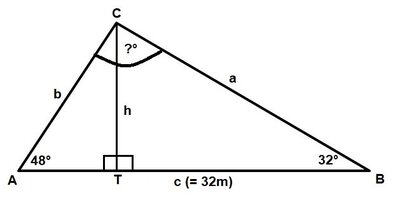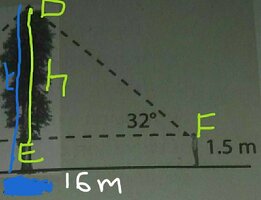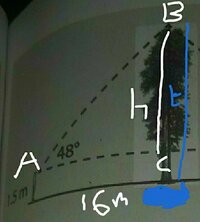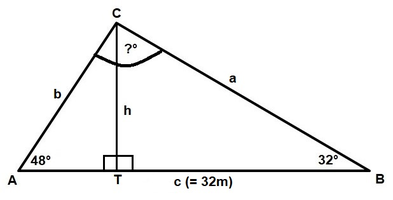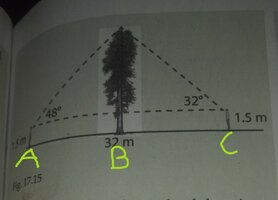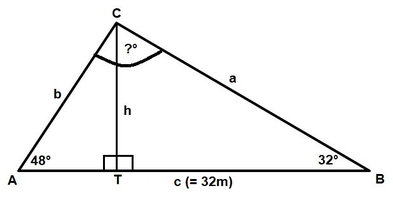It might look slightly misleading, but having I am sure
@The Highlander meant the AB, not TB. Note that the sides of the large triangle are labeled [imath]a,b,c[/imath], which make me things that "c(=32m)" refers to the whole side AB.
Yes. I am just seeing that now.Thank you.
View attachment 35773
Let
AT = x
TB = 32- x
CT = h
h/x = tan(48)
h/(32-x) = tan(32)
x * tan(48) = (32 -x) * tan(32)
x = 32 * tan(32)/[tan(32) + tan(48)]
h = x * tan(48)
h = 32 * tan(48) * tan(32)/[tan(32) + tan(48)]
You know what? I was following all the lines of your work till I got to the line below.
h = 32/[cot(32) + cot(48)]..............................................How would you check this answer??
So could you please explain how [math]\frac{32tan(48) \times tan(32)}{tan(32)+tan(48)}[/math] gave rise to [math]\frac{32}{cot(32)+cot(48)}[/math]Or more precisely, how is [math]32tan(48) \times tan(32)=32[/math] and [math]tan(32)+tan(48)=cot(32) + cot(48)[/math]But I think it all boils down to this
[math]h=\frac{0.624869351\times1.110612515}{1.110612515+0.624869351} \\
= \frac{22.20760712}{1.735481867}[/math][math]h=12.79621962[/math]
But I would appreciate if you choose to explain.
Attempting to add dimensions onto the diagram in the original question is not the same as drawing your own sketch!
Yes, but that helps me in away. Atleast, I understood that I have to use trigonometric ratios in solving the problem. It also helps me to explain my thought on the problem at hand though not accurate.
The diagram in the question is clearly inaccurate (quite possibly deliberately so, to encourage unwary students to make the same mistakes as you did?) and that is why it is important that you make your own sketch of the problem.
A sketch does not need to be geometrically accurate (mine isn't; those angles are not 32° or 48°!) though it does no harm to make it as close as possible; the use of a protractor &straight edge would allow the construction of a more accurate sketch than mine but what is important is that the sketch is correctly labelled and all the correct dimensions are added in the correct places.
Yes. You are on point.
If you had just started by drawing a triangle similar to the (isosceles?) one in the question, once you added in the angles it would become obvious (I would hope) that it wasn't the correct geometry and you would then be 'prompted' to redraw the triangle to be more like my sketch.
However, even if you didn't re-draw the triangle (as scalene rather than isosceles) but did correctly label it (as in my sketch) that would still enable you to correctly answer the question by just ignoring the incorrect geometry and using the information provided (in the sketch) in the correct way!
Yes. Very true.
There is a (to the best of my knowledge &belief) universally accepted convention for labelling triangles; are you not familiar with this?
I am very familiar with it but carelessly ignored it.
(If not, then you need to read this!) To summarize: the vertices are labelled with capital letters (eg: A, B & C) and the side opposite each vertex is labelled with the corresponding lower-case letter (ie: a, b & c); in a right-angled triangle the right-angle usually takes the third (in alphabetical order) letter (so that a2 + b2 = c2).
That is why (in my sketch) c represents the line AB, not any segment of it, and also why I added "= 32m" in brackets thus making it absolutely clear what length it was so there should have been no confusion whatsoever as to what c was (for anyone paying any attention)!
The point T was added simply to facilitate the naming of the two distances the boys were from the tree (as AT & BT). I suppose I might have put that label inside the triangle but the little squares (identifying the right angles) were already there and I very much doubt that anyone else looking at that diagram would have misinterpreted it the way you appear to have!
Yes. It is just now that I understood the sketch.Thank you.
Those are not sketches. As explained earlier, you should not be just adding dimensions to a 'provided' diagram but drawing your own sketch of a situation.
Yes that is true, but I felt that on this one no need for making another diagram since I can understand the problem even if the original diagram is labelled appropriately and used to explain the problem to me (not necessarily drawing new one) like what you showed in your sketch can still be shown in the original diagram this way
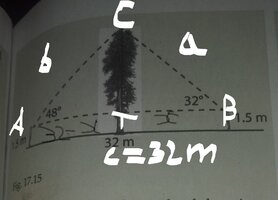
That way you are thinking about the situation you are faced with and (especially in this case) are likely to realise the problem with the original diagram in the question!
Yes.
Please draw your own sketches in future (you can just use mine in this case).
Yes I will. You know I do. But for this one, I felt it wasn't necessary since a diagram has already being provided.
He could "check" it by calculating "h" using the much simpler approach outlined at Post #5 (q.v.)!
Did you not read all the way through that post (before you nicked my diagram? ?).
Are you deliberately trying to confuse the OP (even further)?
No, he does no such thing. I think I understand this method better than the sine rule you are suggesting:
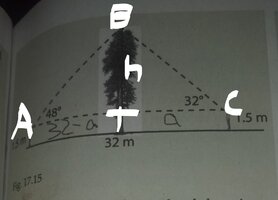
from triangle ABT [math]tan(48)=\frac{h}{32-a}[/math]from triangle BTC [math]tan(32)=\frac{h}{a}[/math][math](32-a)tan(48)=h[/math][math]atan(32) = h[/math][math]a=\frac{32tan(48)-h}{tan(48)}[/math][math]a=\frac{h}{tan(32)}[/math][math]\frac{32tan(48)-h}{tan(48)}=\frac{h}{tan(32)}[/math][math]h=\frac{tan(32)\times 32tan(48)}{tan(48)+tan(32)}[/math][math]h=\frac{0.624869351\times1.110612515}{1.110612515+0.624869351} \\
= \frac{22.20760712}{1.735481867}[/math][math]h=12.79621962[/math]Complete height of tree [math]=12.79621962+1.5 \\
\approx 14.3 m[/math]To evaluate distance of the boy looking at the top of tree from the tree through an angle of elevation of 32 degree:
From triangle BTC, [math]a=\frac{h}{tan(32)}[/math][math]a=\frac{12.79621962}{0.624869351} \approx 20.5m[/math][math]\therefore[/math] the boy is standing at distance of 20.5m from the tree.
To evaluate distance of the boy looking at the top of tree from the tree through an angle of elevation of 48 degree:
[math]32-20.47823213 \approx 11.5 m[/math]The last guy is standing at distance of 11.5 m from the tree.
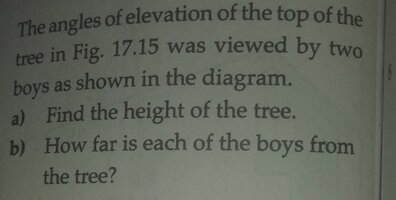
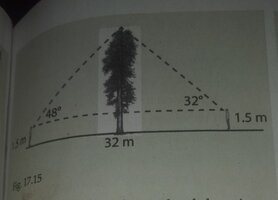 This is what I did. I thought that the big triangle is bisected into two equal triangles thereby bisecting the distance 32m into 16m each.View attachment 35764
This is what I did. I thought that the big triangle is bisected into two equal triangles thereby bisecting the distance 32m into 16m each.View attachment 35764
